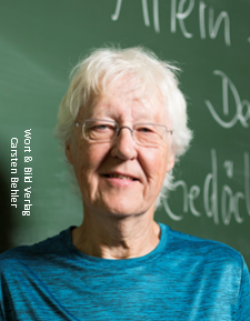Neural Plasticity Lab
Neurologische Klinik
Medizinische Fakultät
Berufsgenossenschaftliches Universitätsklinikum Bergmannsheil Bochum
Ruhr-Universität Bochum
Universitätsstr. 150
44801 Bochum
Tel:
+49 (0)234 32-25565
Email:
hubert.dinse@ruhr-uni-bochum.de

Research in the Neural Plasticity Lab focuses on neuronal plasticity, which describes the ability of brains to adapt continuously during the entire lifespan to new experiences and constraints imposed by the environment. Our main goal is an understanding of learning and aging under a neuroplasticity perspective. In addition, we search for new strategies and measures in rehabilitation and intervention based on targeted neuroplasticity.
What are conditions that facilitate learning, or that impede it? We have been trying to obtain insight by adopting canonical stimulation protocols effective in synaptic plasticity research for sensory stimulation to induce learning in humans. The persistency of changes, the ease of application and the wide range of effects make this approach an ideal tool in the targeted intervention for improving perception, behaviour and cognition not only in adult, but also in aged or impaired populations. Our Lab is widely connected in collaborations with Labs and Institutions who complement our expertise.
Methods used include tactile and visual psychophysics, recording of somatosensory and visual evoked potentials (SEPs) and of high-density EEG (256 channels). In collaboration projects, we use functional magnetic resonance imaging (MRI) and transcranial magnetic stimulation (TMS).
Brickwedde, M., Krüger, M. C., & Dinse, H. R. (2019). Somatosensory alpha oscillations gate perceptual learning efficiency. Nature Communications, 10(1), 263. https://doi.org/10.1038/s41467-018-08012-0
Kattenstroth, J. C., Kalisch, T., Sczesny-Kaiser, M., Greulich, W., Tegenthoff, M., & Dinse, H. R. (2018). Daily repetitive sensory stimulation of the paretic hand for the treatment of sensorimotor deficits in patients with subacute stroke: Reset, a randomized, sham-controlled trial. BMC Neurology, 18(1), 2. https://doi.org/10.1186/s12883-017-1006-z
Heba, S., Puts, N. A., Kalisch, T., Glaubitz, B., Haag, L. M., Lenz, M., Dinse, H. R., Edden, R. A., Tegenthoff, M. & Schmidt-Wilcke, T. (2015). Local GABA Concentration Predicts Perceptual Improvements After Repetitive Sensory Stimulation in Humans. Cerebral Cortex, 26(3), 1295–1301. https://doi.org/10.1093/cercor/bhv296
Philipp, S. T., Kalisch, T., Wachtler, T., & Dinse, H. R. (2015). Enhanced tactile acuity through mental states. Scientific Reports, 5, 13549. https://doi.org/10.1038/srep13549
Muret, D., Dinse, H. R., Macchione, S., Urquizar, C., Farnè, A. & Reilly, K. T. (2014). Touch improvement at the hand transfers to the face. Current Biology, 24(16), R736–R737. https://doi.org/10.1016/j.cub.2014.07.021
Kattenstroth, J.‑C., Kalisch, T., Holt, S., Tegenthoff, M., & Dinse, H. R. (2013). Six months of dance intervention enhances postural, sensorimotor, and cognitive performance in elderly without affecting cardio-respiratory functions. Frontiers in Aging Neuroscience, 5, 5. https://doi.org/10.3389/fnagi.2013.00005
Wilimzig, C., Ragert, P. & Dinse, H. R. (2012). Cortical topography of intracortical inhibition influences the speed of decision making. Proceedings of the National Academy of Sciences of the United States of America, 109(8), 3107–3112. https://doi.org/10.1073/pnas.1114250109
Seitz, A. R. & Dinse, H. R. (2007). A common framework for perceptual learning. Current Opinion in Neurobiology, 17(2), 148–153. https://doi.org/10.1016/j.conb.2007.02.004
Dinse, H. R., Ragert, P., Pleger, B., Schwenkreis, P. & Tegenthoff, M. (2003). Pharmacological Modulation of Perceptual Learning and Associated Cortical Reorganization. Science, 301(5629), 91–94. https://doi.org/10.1126/science.1085423
Pleger, B., Dinse, H. R., Ragert, P., Schwenkreis, P., Malin, J. & Tegenthoff, M. (2001). Shifts in cortical representations predict human discrimination improvement. Proceedings of the National Academy of Sciences of the United States of America, 98(21), 12255–12260. https://doi.org/10.1073/pnas.191176298